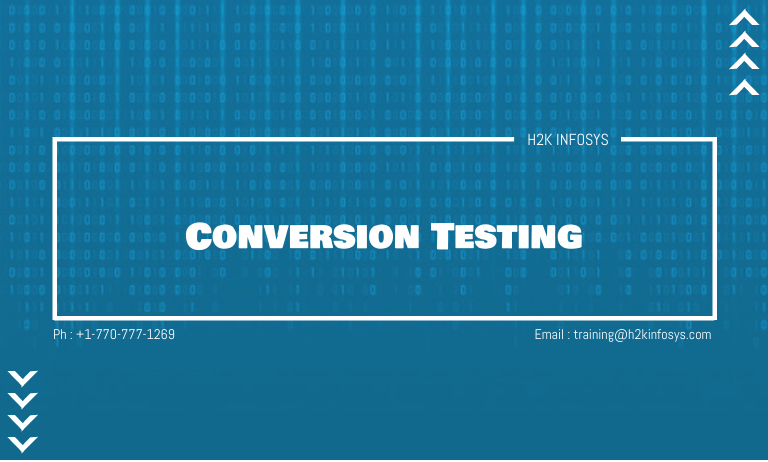Conversion Testing

Conversion Testing is used to verify zone data format will be converted into another data format so that the converted data format will be seamlessly by the application under the test appropriately. Any type of data can be converted from any form to another, for web-based application, the web pages should be of the form HTML that should agree to W3C HTML specification so that browsers which can render the page correctly.
Generally conversion testing is about showing the different content to the people who will access our website and then measuring the impact of change on your conversions and conversion rate.
Conversion testing allows us to see if the change and its impact is real or just coincidence. In essence, you want to ensure that change which has a positive effect, if we have to do this testing we need enough data which makes sure that we are seeing true results.
Measuring Conversions
When we start testing, to optimise our conversions we need to make sure that we are measuring conversions. This will be achieved using Google Analytics and we want to ensure that we are measuring macro-conversion and micro –conversion.
A micro-conversion is a high value interaction, think of them as the most important things we are trying to get people to do on our website. The most common types of macro-conversions are leads and are transactions if we are selling online.
There are macros conversions, these conversions are secondary objectives they are not critical actions that we want people to perform but are still provide some values because here people are engaging with deeper actions. Consider examples like downloading PDF, watching video, commenting or logging into a members area.
Common examples of conversion testing are:
- Button Color-when we test whether blue cotton converts at higher rate than a red button.
- Background Image- For example, it tests whether background image converts at a higher rate than a normal plain image.
- Offer- For example, it tests whether free shipping of products of $40 or less, and converts 10% discount.
- Pop up- consider an example, it tests whether the pop-up converts at a higher rate rather than flyout for mobile visitors.
Levels of data conversion testing:
We have mainly two levels of testing is done like technically and business, Warm and Fuzzy testing. Technical testing checks conversion against the spaces while business testing will give business representatives the confidence when their old system will be in rest the data copied flawlessly to new system.
- Technical testing
We should start the technical test by establishing the test traceability. Once the test be written against each statement as previous to make sure test will cover all data to be converted. We should initiate this testing by establishing test traceability. There are mainly two common queries:
- Row count- These are used to compare no of records in source and target table. If the conversion is straight conversion, above queries can easily check number of rows. For example,
Run against Source Table,
Choose count(*) from [Source table] where [field1] = [a condition] [field2] = [another condition] Run against Target Table, Choose count(*) from [Target table]
This test will give us number of subset table which are to be converted and total number of rows in target table.
- Identify objects with Missing data
It tests each parent will have their corresponding child object we write the sql query following steps.
Write a query which gets the foreign key that goes back to parent table from child objects table. e.g.
where [field1] = [value1] AND [field2] = [value2] AND [field3] = [value3]
Write a query where parent table that gets all the parent_id’s that should be child object in ChildObjectTable e.g.
Choose id from parentTable where [fieldX] = [a value]






Conversion Testing: Testing of programs or procedures used to convert data from existing systems for use in replacement systems. It is usually performed by the QA teams. Conversion Testing is used to any type of data can be converted from any form to another. For web-based application, the web pages should be of the form HTML that should agree to W3C HTML specification so that browsers which can render the page correctly.
Generally, conversion testing is about showing the different content to the people who will access our website and then measuring the impact of change on your conversions and conversion rate.
Conversion testing: is used to verify zone data format will be converted into another data format so that the converted data format will be seamlessly by the application under the test appropriately. Conversion testing is showing people the difference when they are viewing the website and measuring the impact of change on your conversions and conversion rate. Conversion testing Common examples of conversion testing are:
1. Button Color-when we test whether blue cotton converts at higher rate than a red button.
2. Background Image- For example, it tests whether background image converts at a higher rate than a normal plain image.
3. Offer- For example, it tests whether free shipping of products of $40 or less and converts 10% discount.
4. Pop up- consider an example, it tests whether the pop-up converts at a higher rate rather than flyout for mobile visitors.
Conversion Testing is used to verify zone data format will be converted into another data format so that the converted data format will be seamlessly by the application under the test. conversion testing is about showing the different content to the people who will access our website and then measuring the impact of change on your conversions and conversion rate.
Some common Test Examples :
• Button Color
For example we test whether a blue button converts at higher rate than a red button.
• Background Image
For example it tests whether background image converts at higher rate than a normal plain image.
conversion testing is used to verify the zone data format will be converted into another data format will be seamlessly by the application under the test appropiately.it allows us to see if the change and its impact is real or just a coincidence.
Conversion Testing is used to verify zone data format will be converted into another data format so that the converted data format will be seamlessly by the application under the test appropriately. Any type of data can be converted from any form to another, for web-based application, the web pages should be of the form HTML that should agree to W3C HTML specification so that browsers which can render the page correctly.
Conversion testing is to verify that one data format can be converted into another data format so that the converted data format can be used seamlessly by the application under test appropriately.
conversion testing is a testing technique that measures the effect of changing the website component.
Breadth Testing involves testing the crucial functionality of a program or a software but it does not dwell on testing the finer details of an application. This test is similar to Smoke testing, Build acceptance testing or Build verification testing. Through this testing we are trying to achieve high level analysis of the application.
Conversion Testing basically measures change in the conversion rate of a website by changing various components of a website like button placement, images, popups, background etc., It gauges the effect of changing different aspects of a website.
Conversion Testing: Testing of programs or procedures used to convert data from existing systems for use in replacement systems. It is usually performed by the QA teams. Conversion Testing is used to any type of data can be converted from any form to another. For web-based application, the web pages should be of the form HTML that should agree to W3C HTML specification so that browsers which can render the page correctly.
Generally, conversion testing is about showing the different content to the people who will access our website and then measuring the impact of change on your conversions and conversion rate.
Conversion Testing is used to verify whether the zone data format will be converted into another data format so that the data format will be converted seamlessly by the application under the test appropriately. Generally conversion testing is about showing different content to the people who will access the website and then measuring the impact of change on the conversions and conversion rate. It allows us to see if the change and its impact is real or just coincidence. Common examples of conversion testing are testing whether a blue button converts at higher rate than a red button, testing whether the background image converts at a higher rate than a normal plain image, testing whether free shipping of products of $40 or less, and converts 10% discount, and testing whether a pop-up converts at a higher rate rather than flyout for mobile visitors.
Conversion Testing is used to verify zone data format will be converted into another data format so that the converted data format will be seamlessly integrated by the application under the test appropriately. Any type of data can be converted from any form to another, for web-based application, the web pages should be of the form HTML that should agree to W3C HTML specification so that browsers which can render the page correctly.
Conversion testing allows us to see if the change and its impact is real or just coincidence. In essence, you want to ensure that change has a positive effect, if we have to do this testing we need enough data which makes sure that we are seeing true results.
convertible testing is used to verify that zone data can be converted into another form of data and any type of data can be converted into any form.
this testing allows us to know about the impact of change in software in real time and if this is true or just coincidence.
we can try this by showing the contents to the real users of software and find the impact on our conversion or conversion rate. two types of testing can be done-Micro testing as primary objective which covers large amount of data and major functions of software.
Macro testing as secondary objective which covers less important functions.